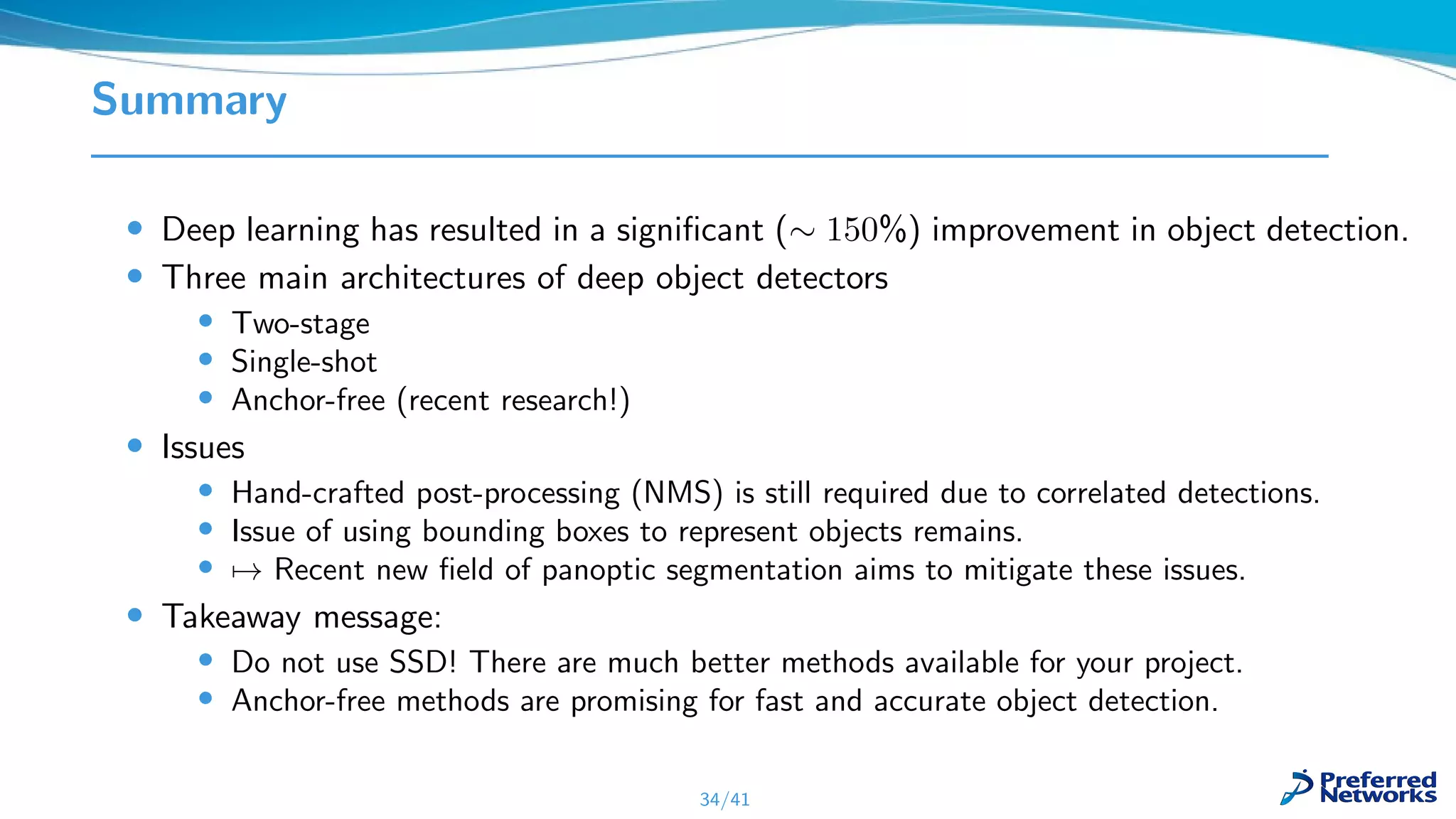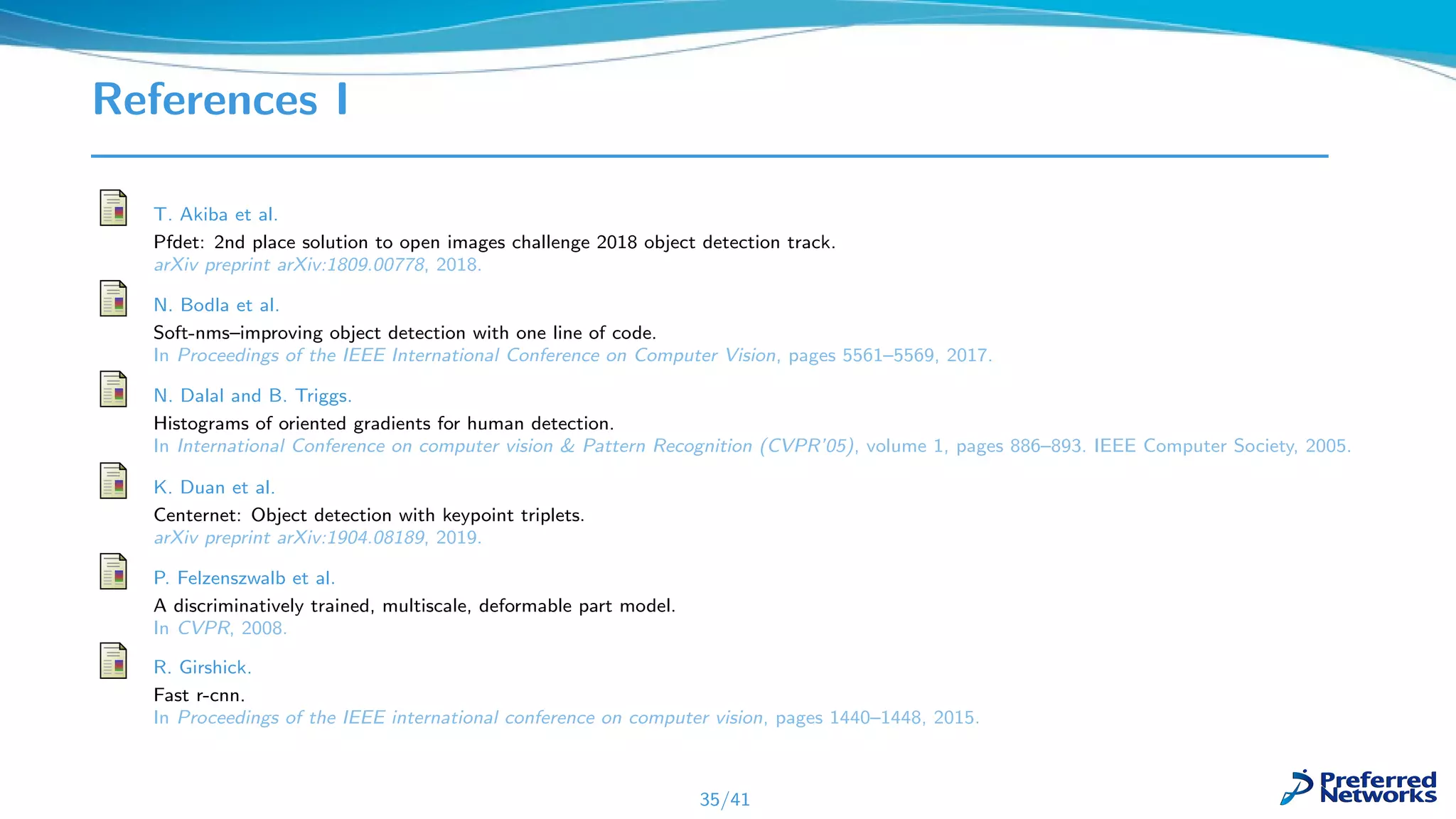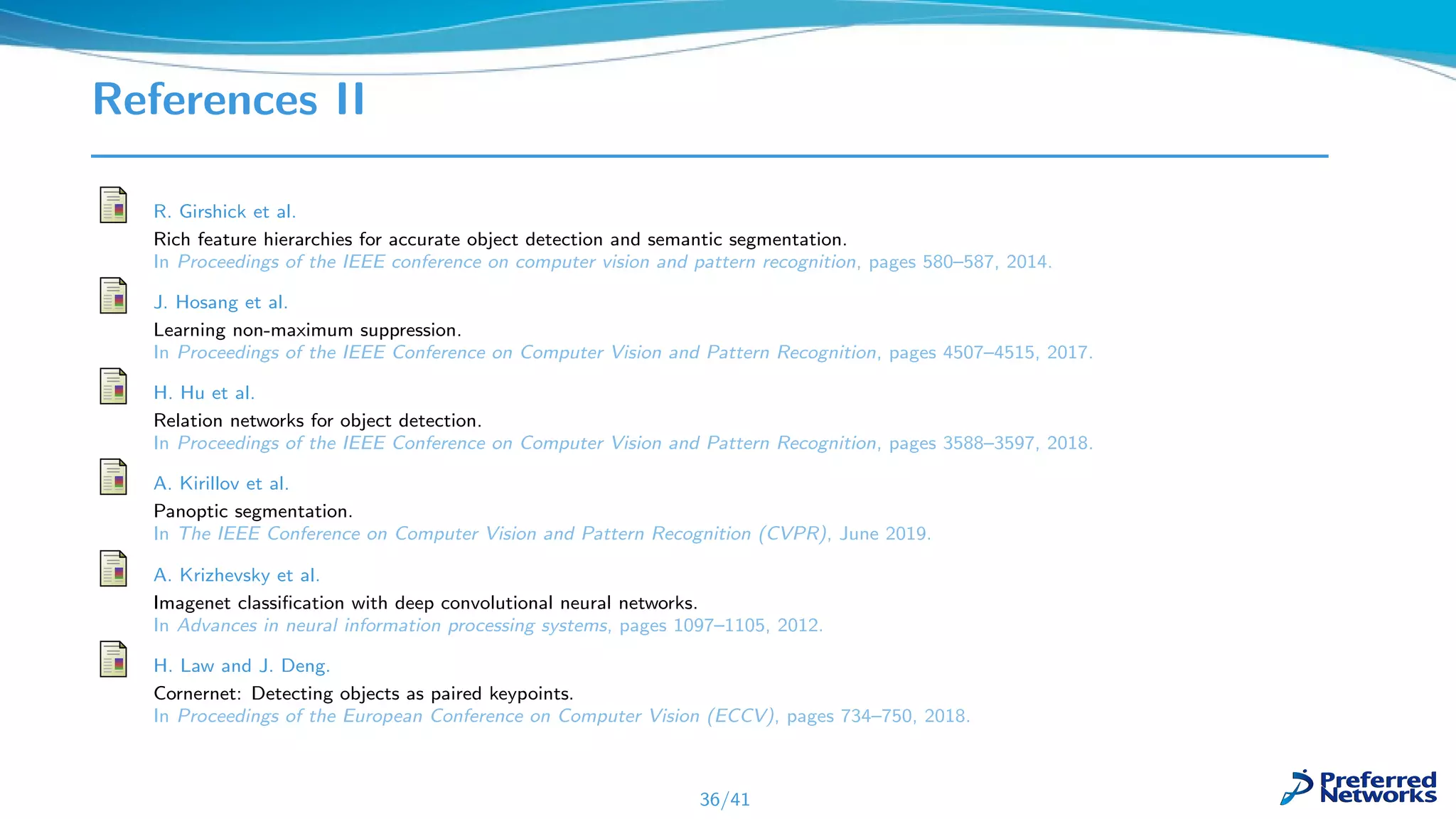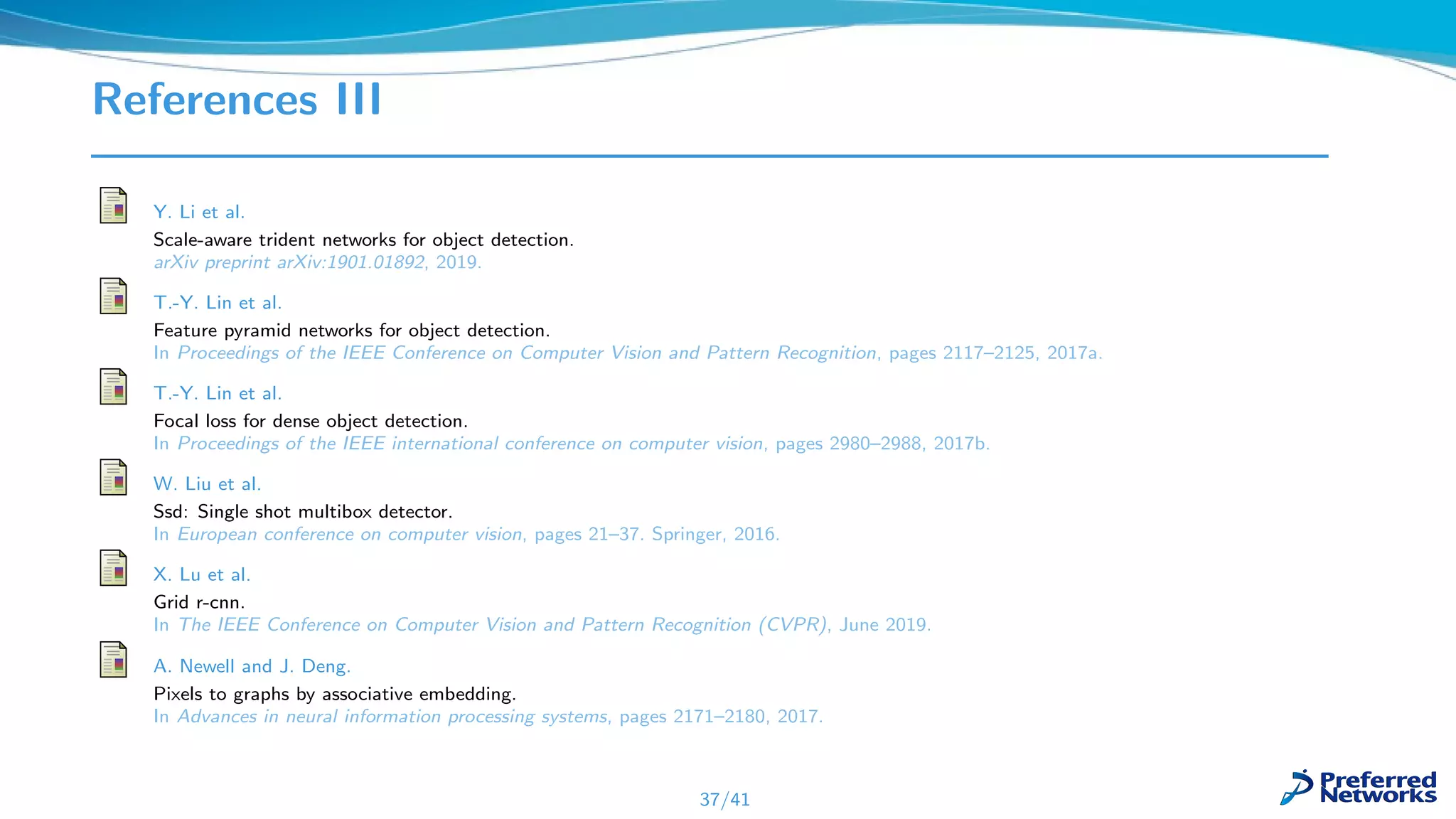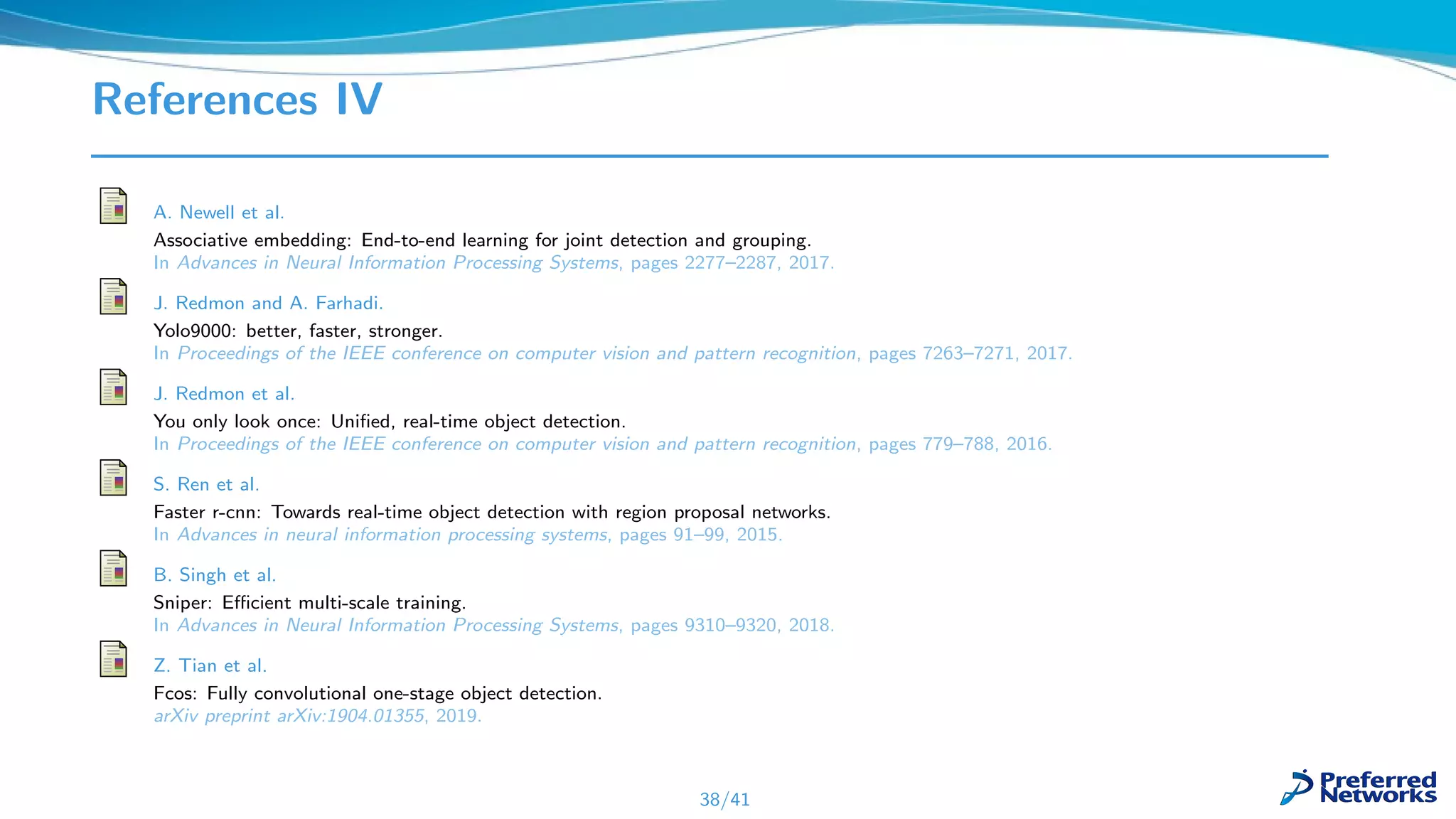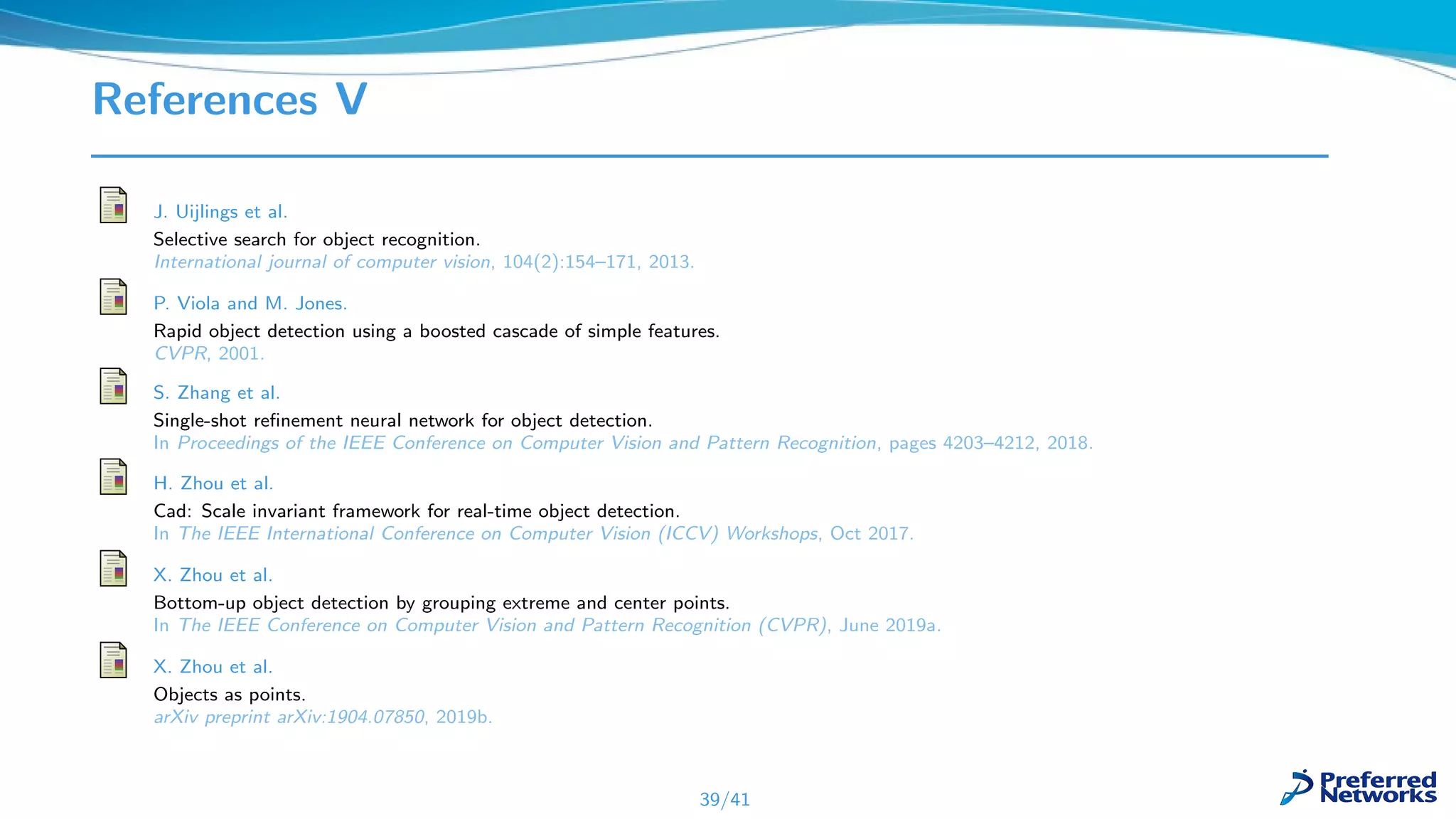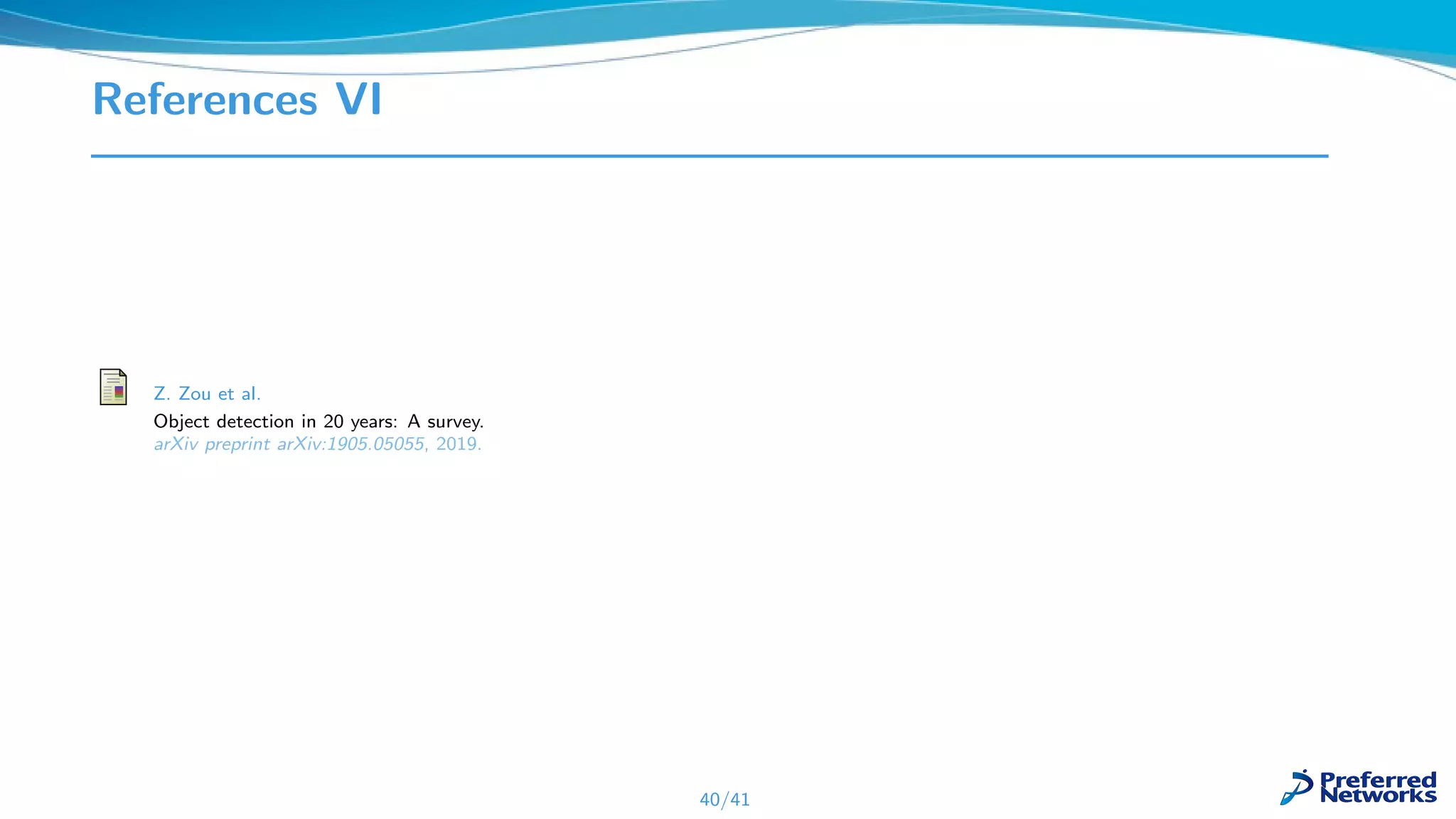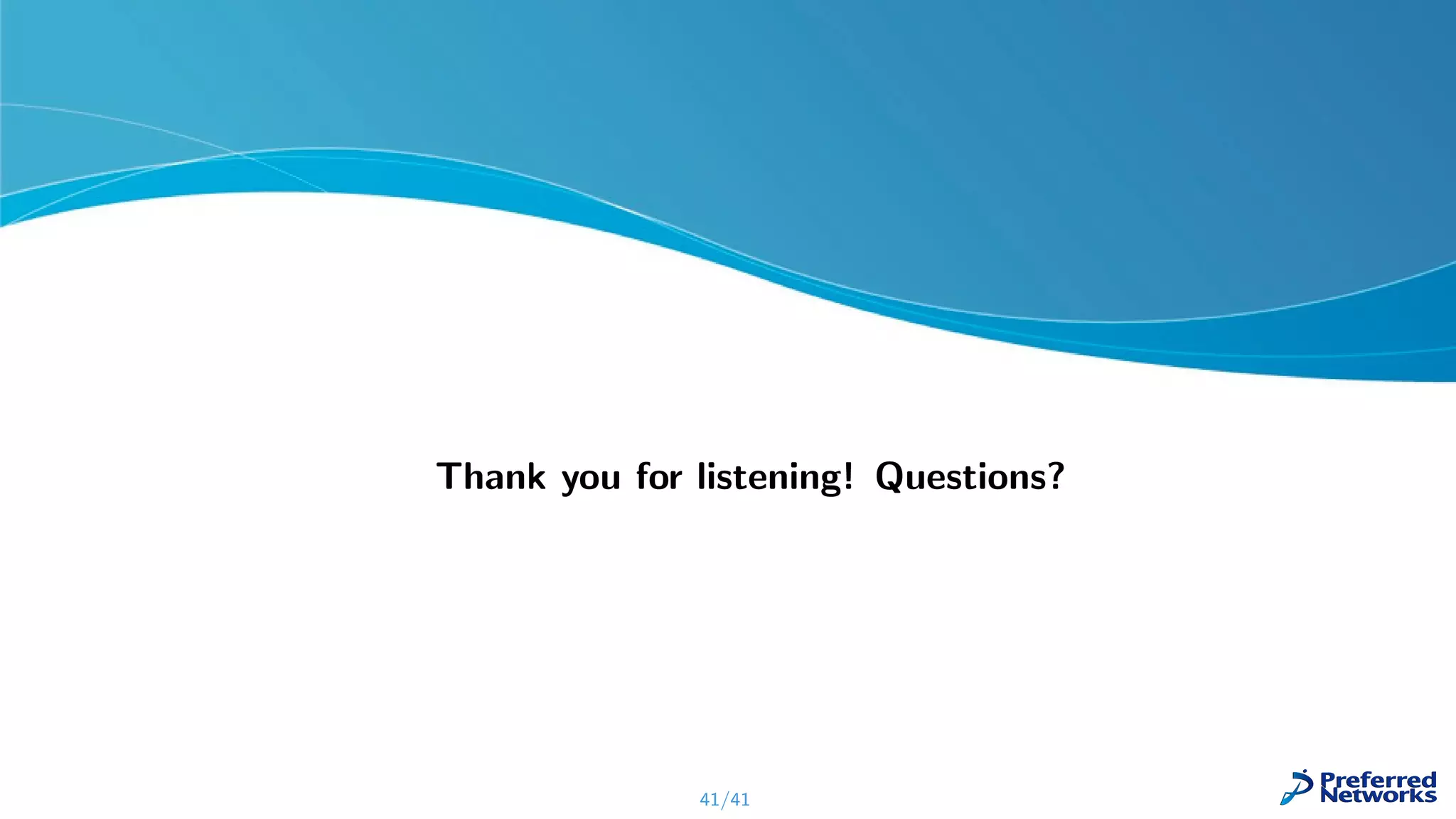The document presents a comprehensive overview of the evolution of object detection methods, detailing the transition from early handcrafted feature techniques to current deep learning approaches. It highlights key methodologies including two-stage methods, single-shot methods, and anchor-free methods, while also addressing ongoing challenges such as the reliance on non-maximum suppression and suboptimal bounding box representations. The conclusion emphasizes the significant advancements brought about by deep learning and suggests that anchor-free methods are increasingly favorable for fast and accurate object detection.

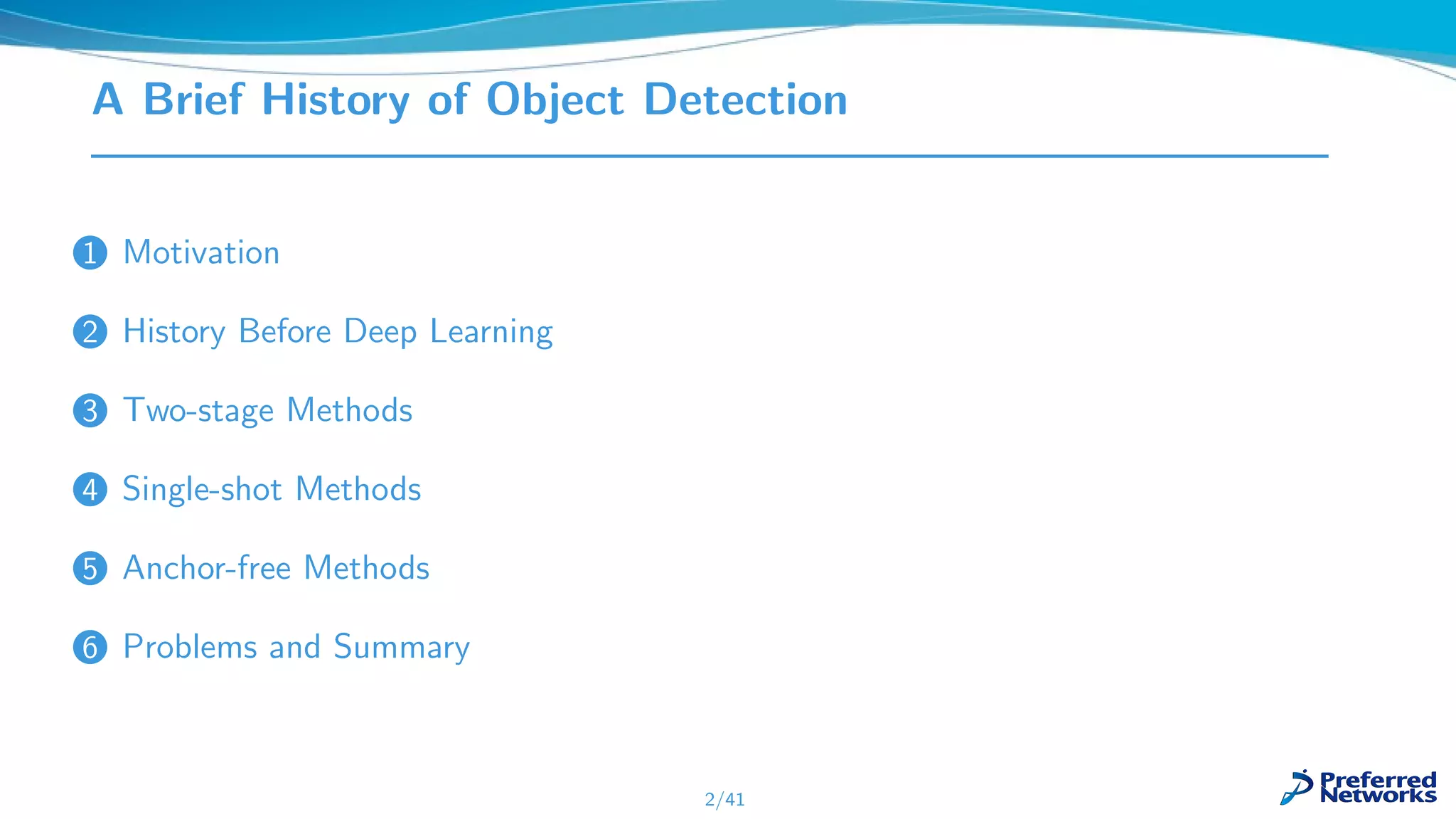
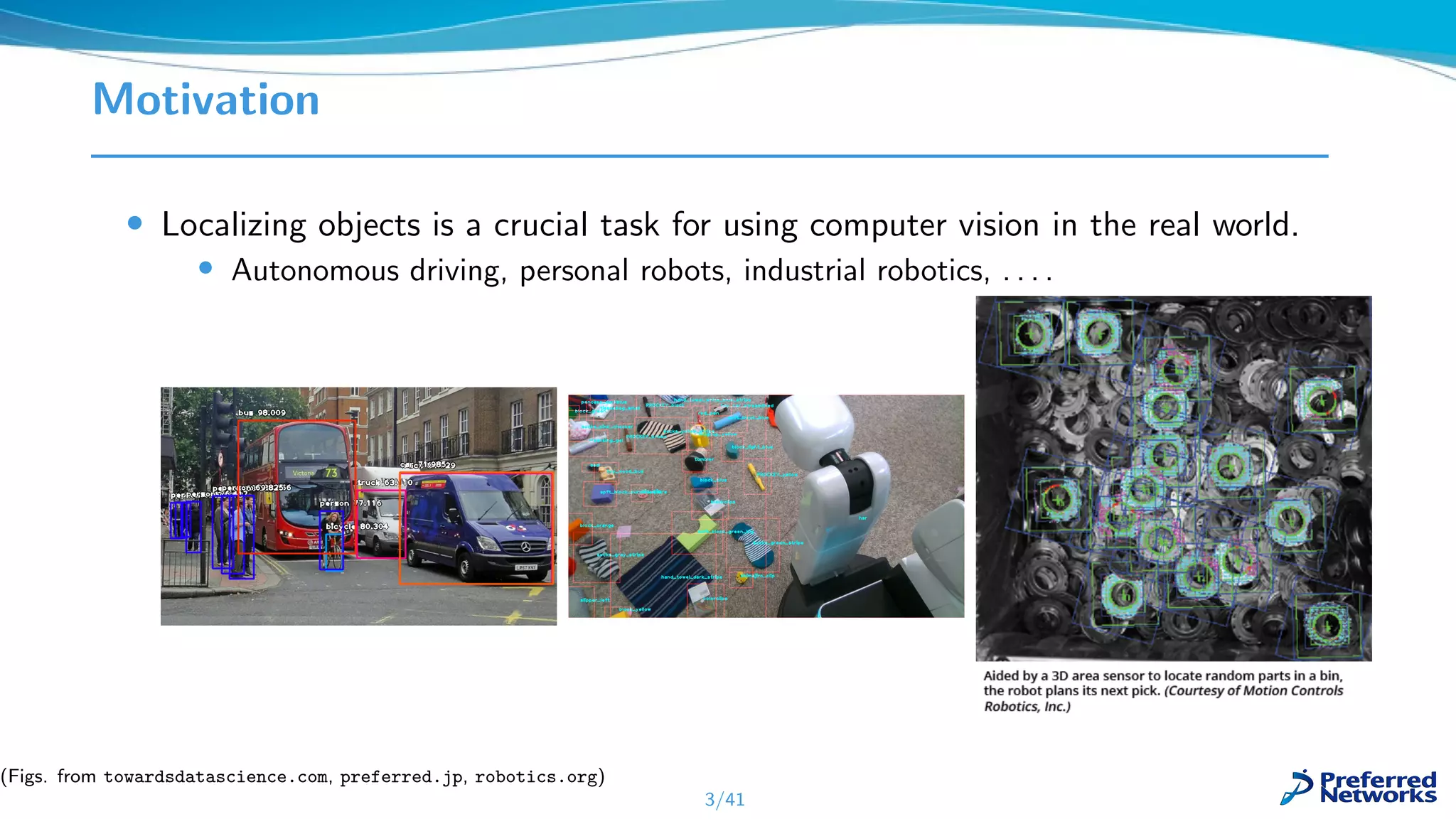
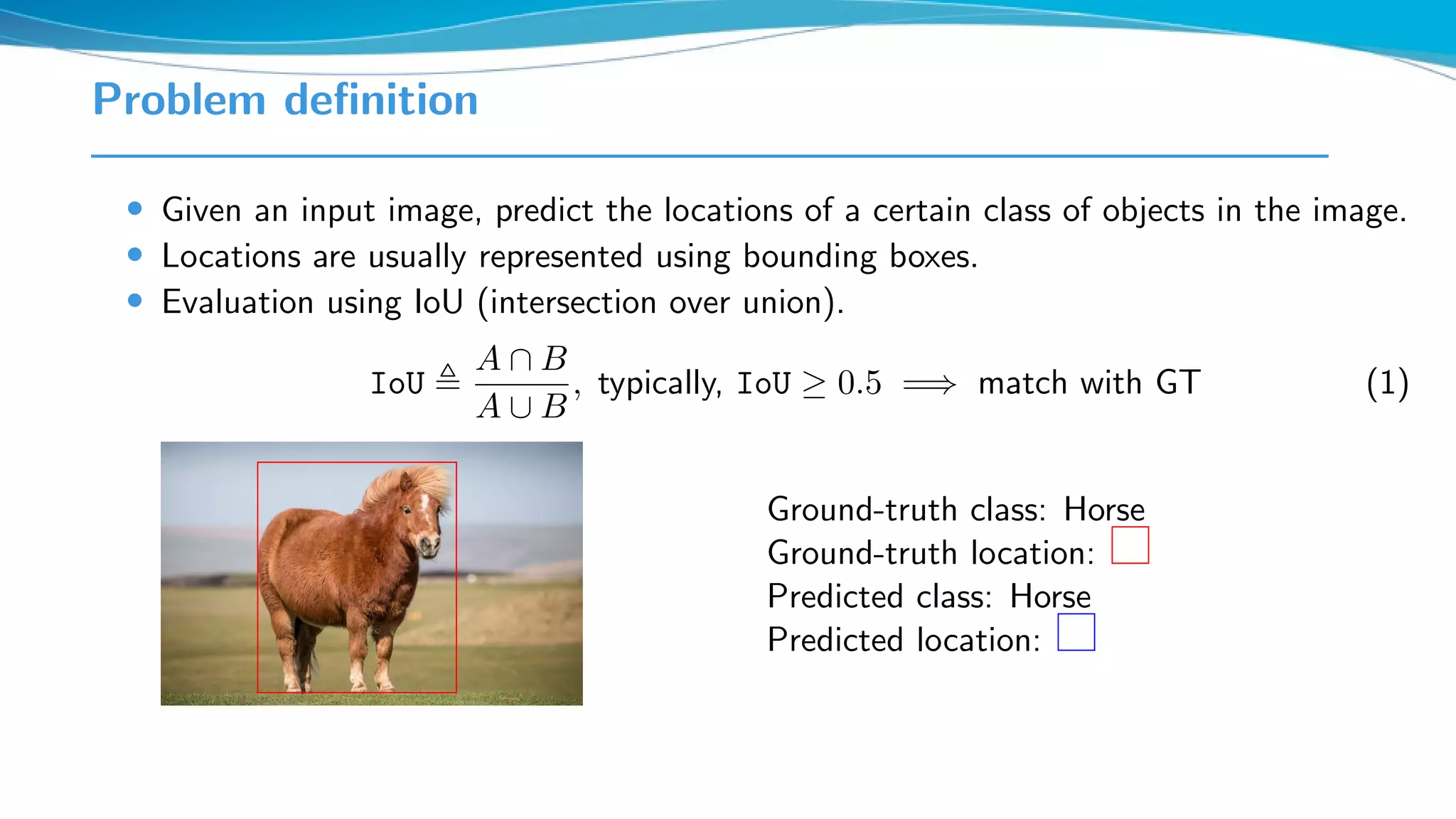
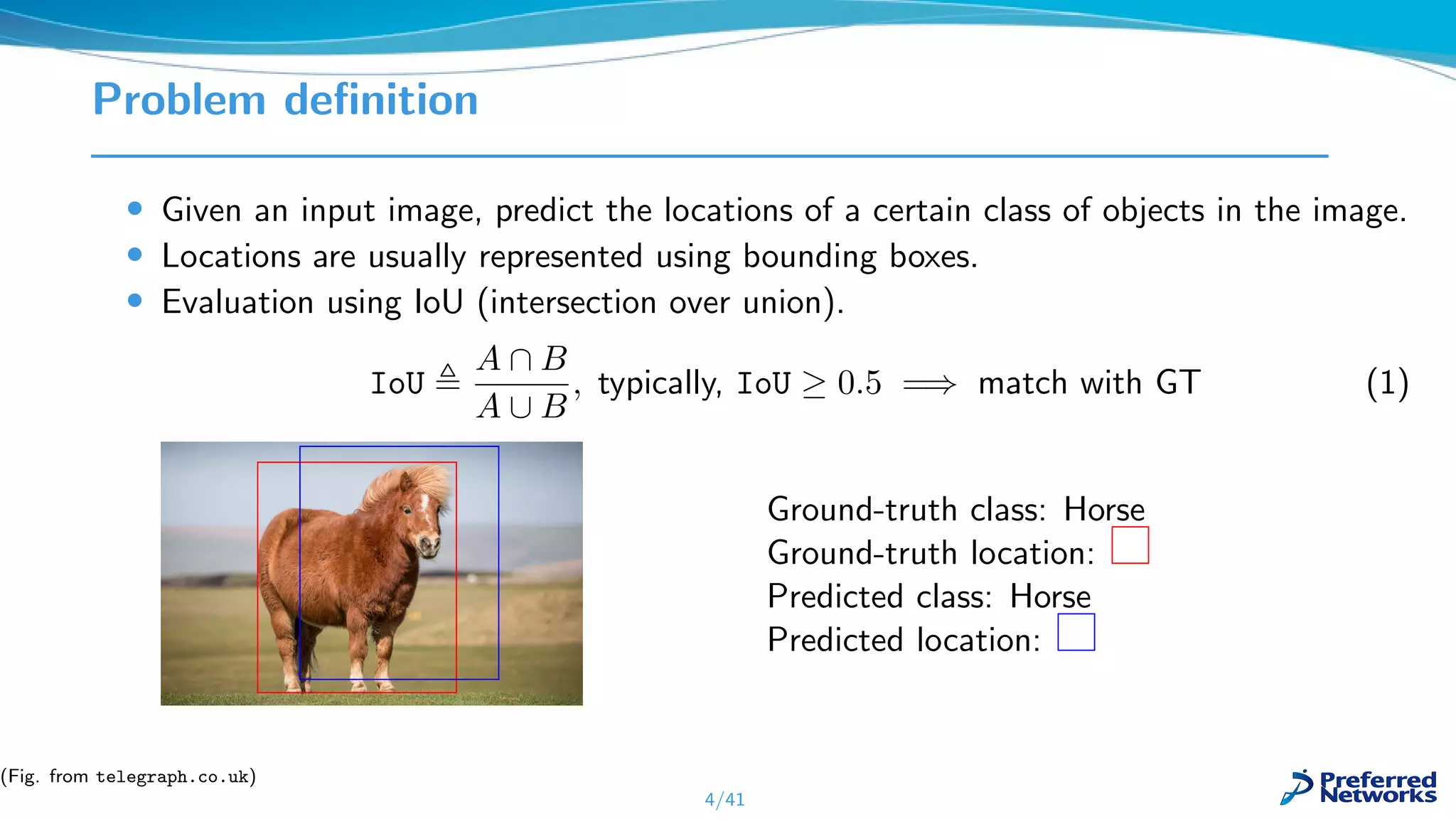
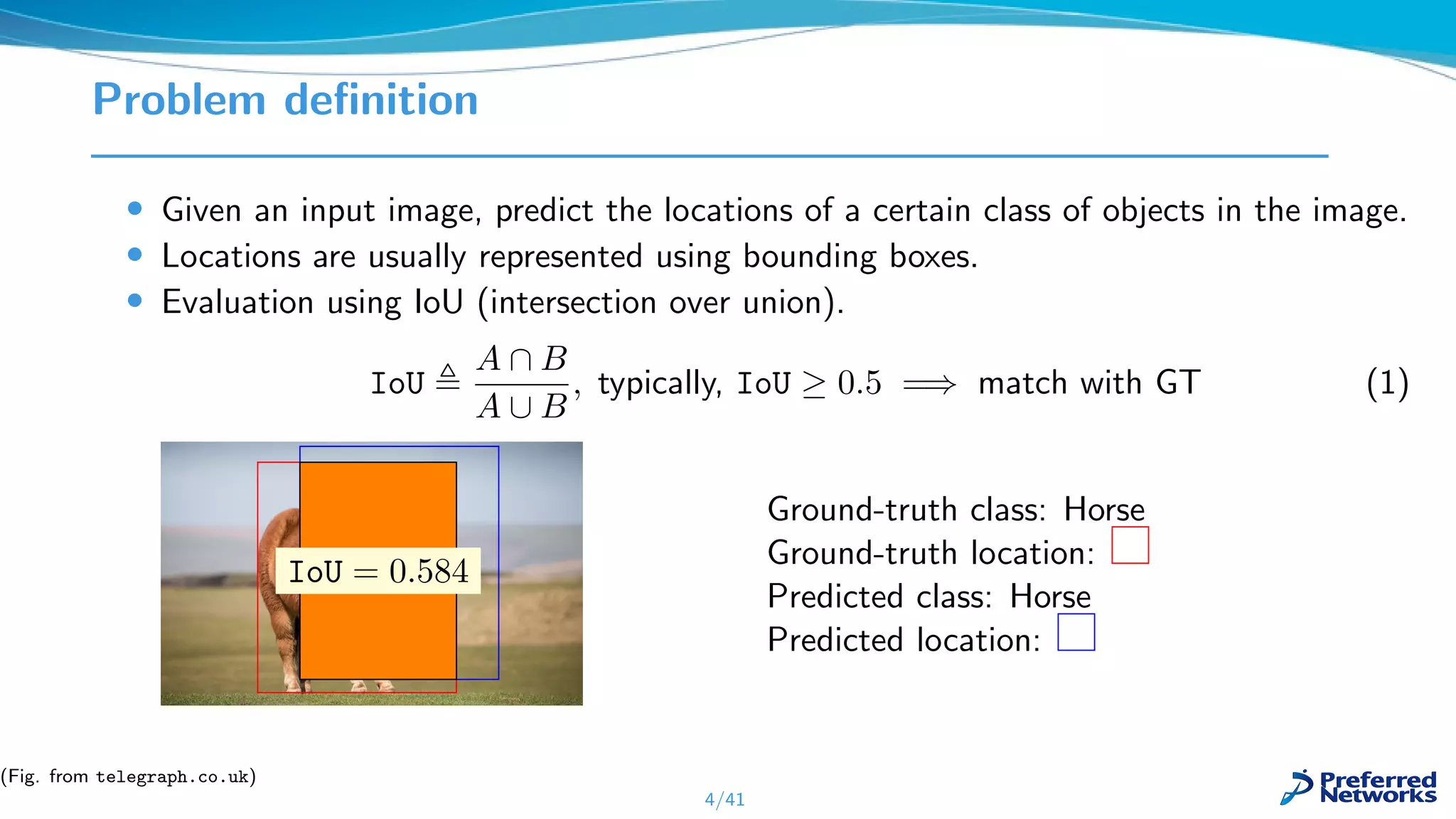
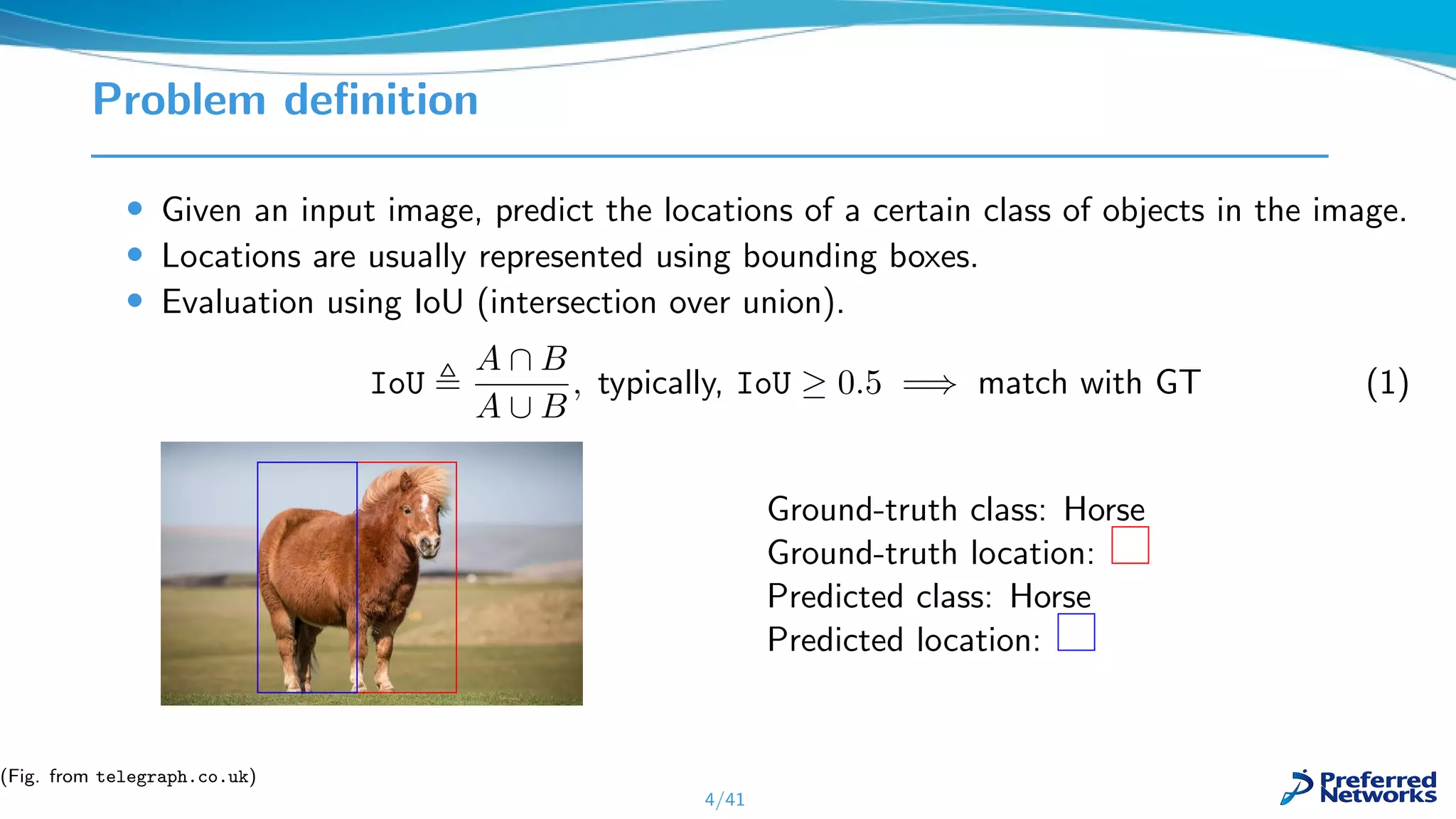

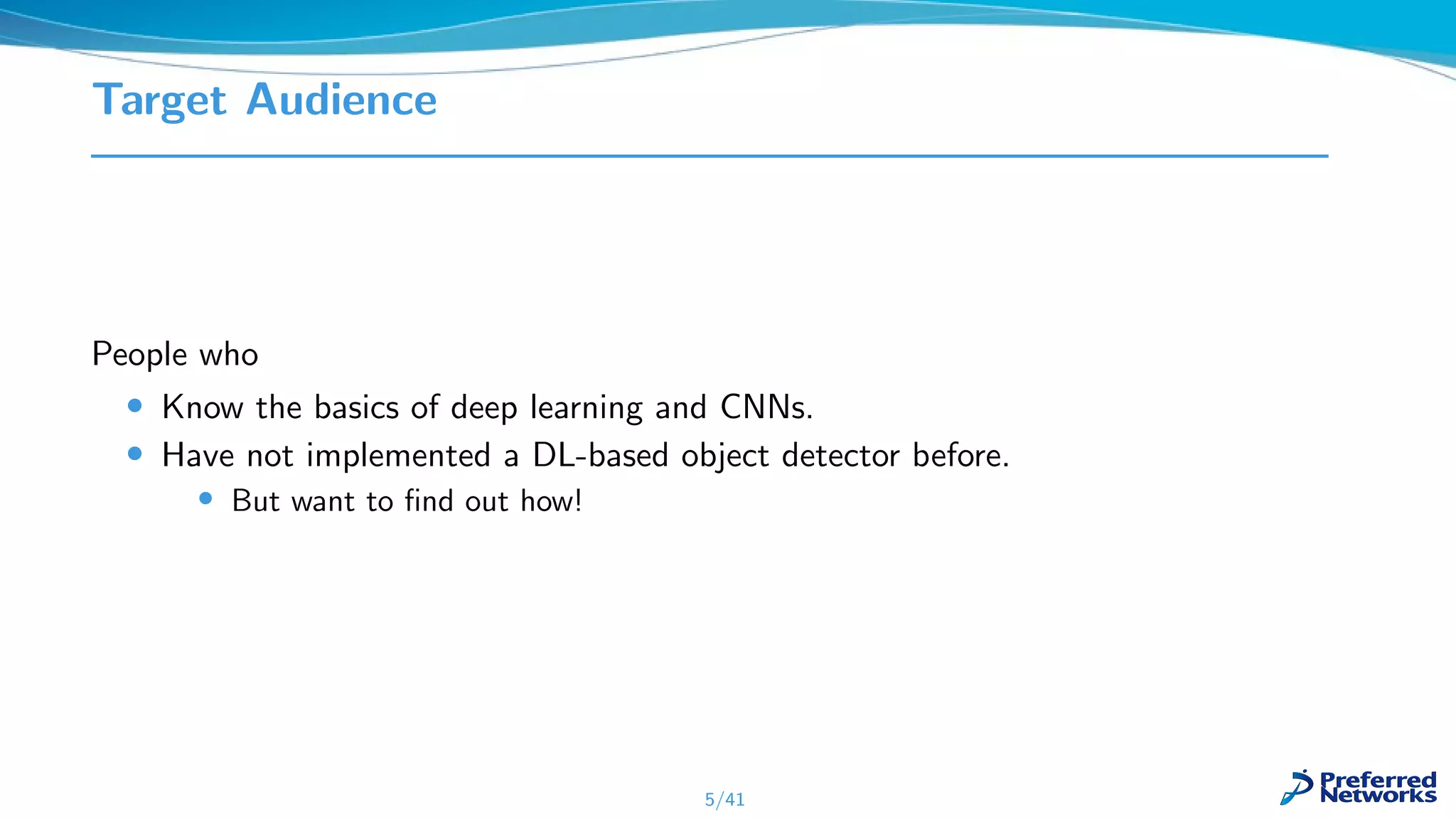
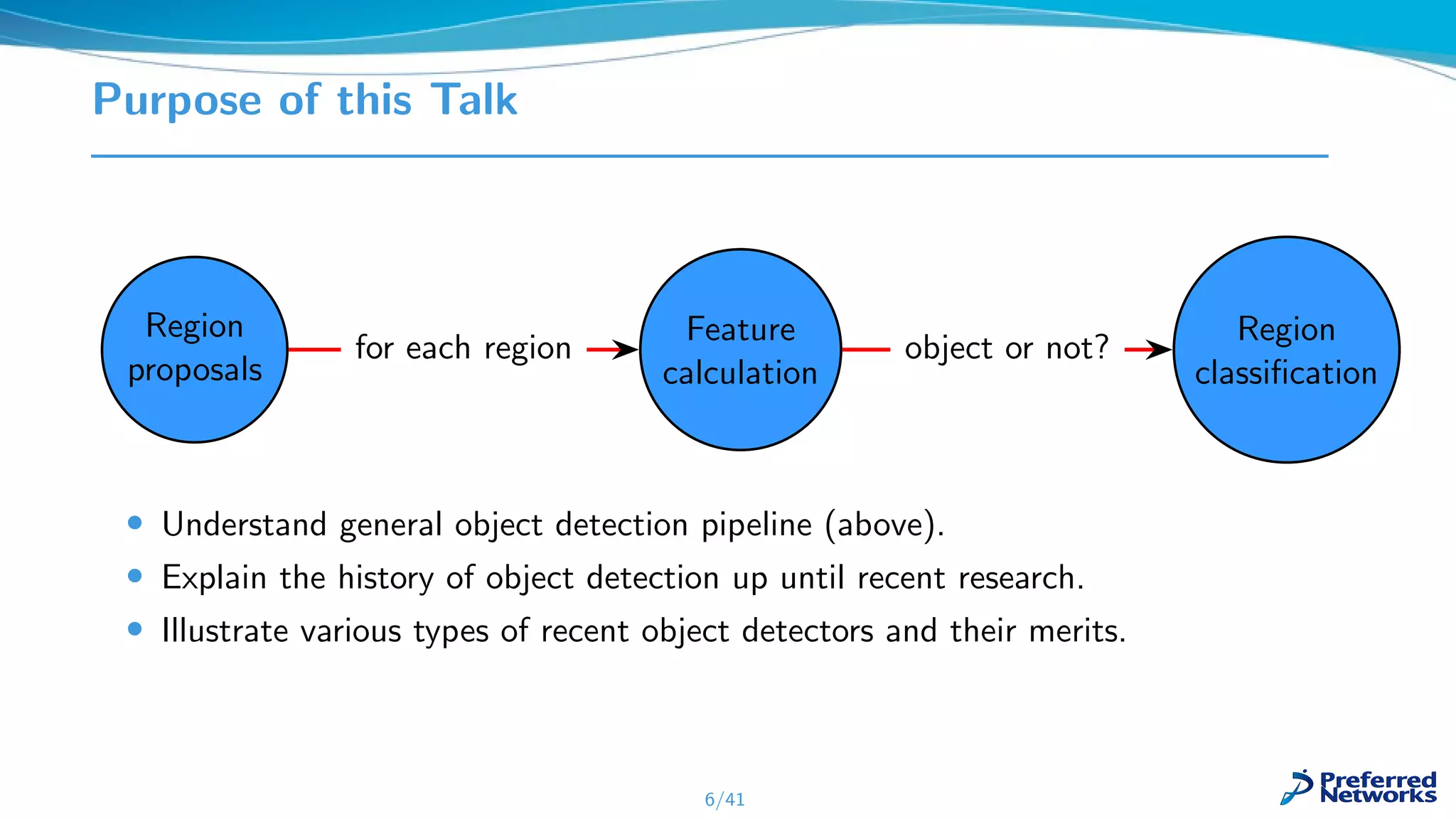
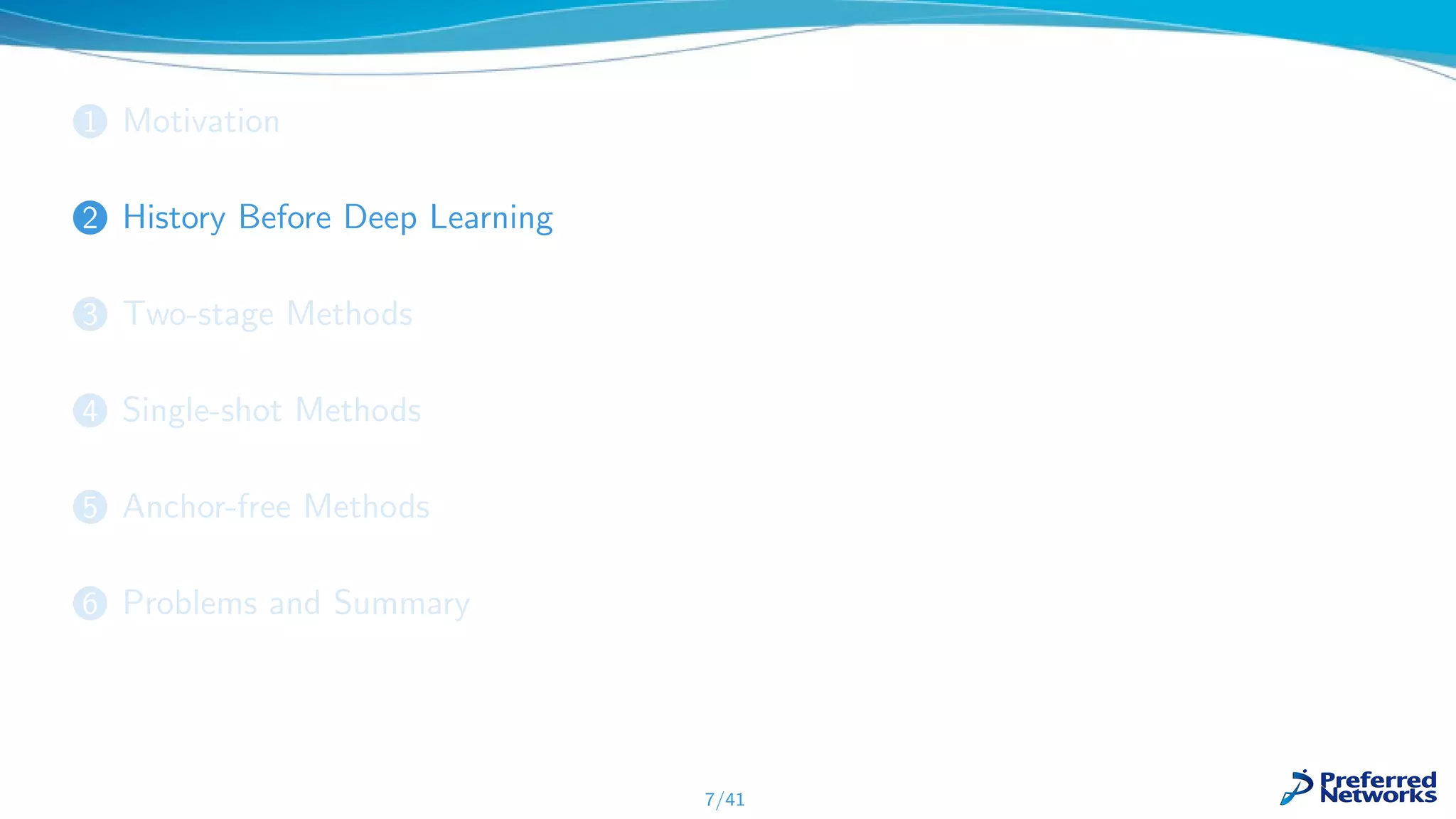
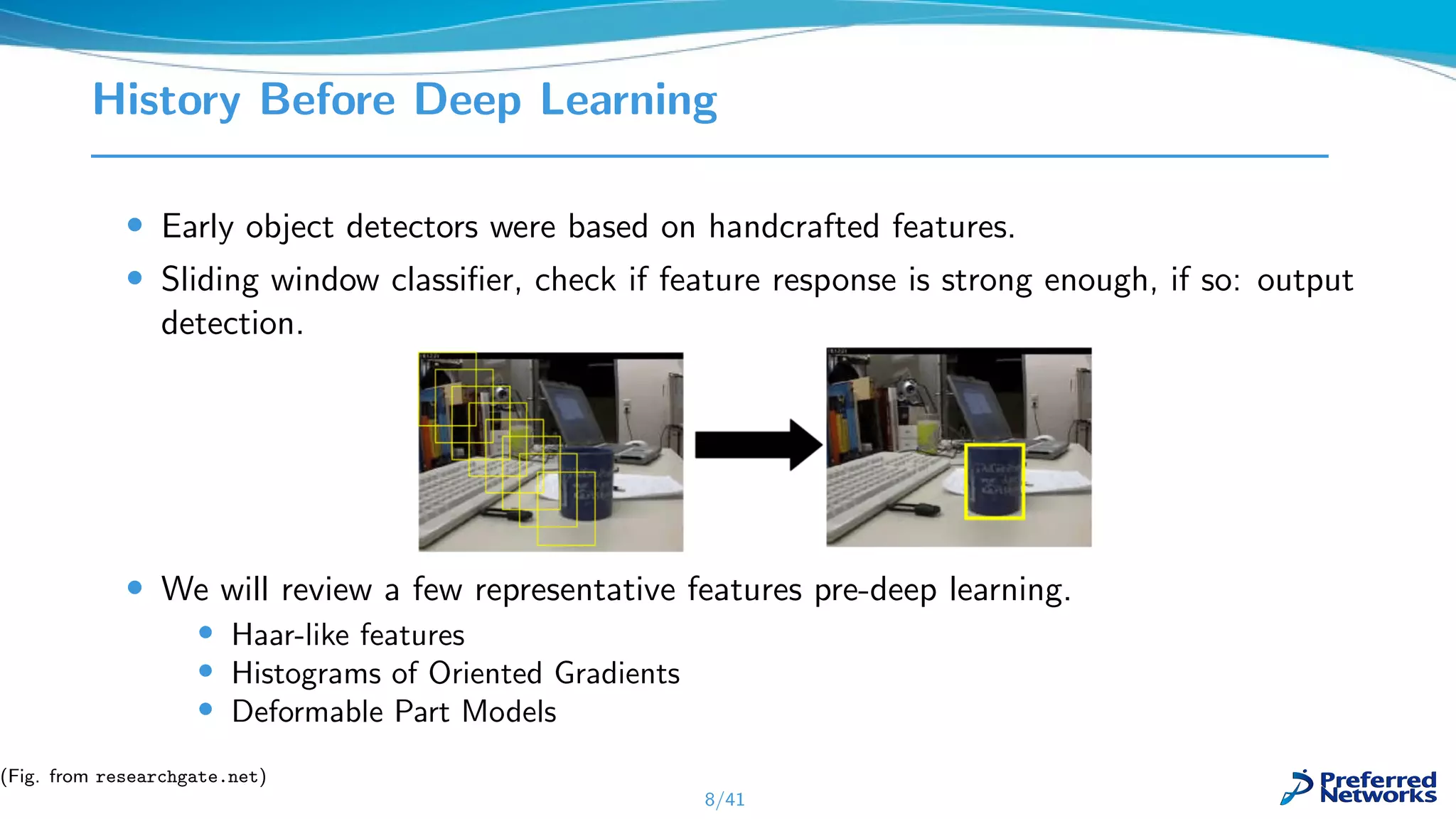
![Haar-like features [Viola and Jones(2001)]
• Hand-crafted weak features, calculate in sliding window, use boosted classifier like
AdaBoost. Name comes from similarity to Haar wavelets.
• e.g. “Is the middle part of the image darker than the outer parts?”
“Nose-detector”
“Eye-detector”
9/41
(Fig. from wikipedia.org)](https://image.slidesharecdn.com/tommi-pfnday4-objctdetection-190926082508/75/A-Brief-History-of-Object-Detection-Tommi-Kerola-13-2048.jpg)
![Necessary Post-Processing: Non-maximum Suppression
• Sliding window classifiers yield lots of correlated detections.
• Non-maximum suppression (NMS) is a simple, greedy algorithm for turning these
into a single detection per object (ideally).
• (Recently, improvements upon NMS exist [Zhou et al.(2017), Bodla et al.(2017)])
10/41
(Fig. from pyimagesearch.com)](https://image.slidesharecdn.com/tommi-pfnday4-objctdetection-190926082508/75/A-Brief-History-of-Object-Detection-Tommi-Kerola-14-2048.jpg)
![Histograms of Oriented Gradients [Dalal and Triggs(2005)]
• Computes histogram of gradient orientation (HOG feature) over sub-image blocks.
11/41
(Fig. from [Dalal and Triggs(2005)])](https://image.slidesharecdn.com/tommi-pfnday4-objctdetection-190926082508/75/A-Brief-History-of-Object-Detection-Tommi-Kerola-15-2048.jpg)
![Deformable Part Models [Felzenszwalb et al.(2008)]
• Learn the relationships between HOG features of object parts via a latent SVM.
12/41
(Fig. from [Felzenszwalb et al.(2008)])](https://image.slidesharecdn.com/tommi-pfnday4-objctdetection-190926082508/75/A-Brief-History-of-Object-Detection-Tommi-Kerola-16-2048.jpg)
![Better Region Proposals: Selective
Search [Uijlings et al.(2013)]
• Instead of sliding window, propose regions that have high “objectness”.
• Oversegment image and merge regions hierarchically by color, texture, size and shape.
13/41
(Fig. from [Uijlings et al.(2013)])](https://image.slidesharecdn.com/tommi-pfnday4-objctdetection-190926082508/75/A-Brief-History-of-Object-Detection-Tommi-Kerola-17-2048.jpg)
![Deep Learning Era [Krizhevsky et al.(2012)]
• Starting with AlexNet in 2012, deep
learning methods significantly improved
image classification.
• The same holds for object detection:
> 30 pp. gap. Recent methods give
∼ 150% improvement.
deep learning gap
14/41
(Fig. from [Zou et al.(2019)])](https://image.slidesharecdn.com/tommi-pfnday4-objctdetection-190926082508/75/A-Brief-History-of-Object-Detection-Tommi-Kerola-18-2048.jpg)

![Two-stage Methods
Image
Region
proposals
Classify
regions
Detections
• As implied, operates in two serial stages:
• Generate region proposals (instead of sliding window).
• Classify each proposed region, if feature response strong enough, output detection.
• When to use? Two-stage methods are accurate but computationally heavy.
• We will look at three historically representative methods:
• R-CNN
• Fast R-CNN
• Faster R-CNN
• (Further reading: [Li et al.(2019), Lin et al.(2017a), Lu et al.(2019), Singh et al.(2018)])
16/41](https://image.slidesharecdn.com/tommi-pfnday4-objctdetection-190926082508/75/A-Brief-History-of-Object-Detection-Tommi-Kerola-20-2048.jpg)
![R-CNN [Girshick et al.(2014)]
• Extract proposals via selective search [Uijlings et al.(2013)].
• Extract CNN features.
• Classify with an SVM.
17/41
(Fig. from [Girshick et al.(2014)])](https://image.slidesharecdn.com/tommi-pfnday4-objctdetection-190926082508/75/A-Brief-History-of-Object-Detection-Tommi-Kerola-21-2048.jpg)
![Fast R-CNN [Girshick(2015)]
• Extract proposals via selective search.
• Extract features and classify with CNN.
18/41
(Fig. from [Girshick(2015)])](https://image.slidesharecdn.com/tommi-pfnday4-objctdetection-190926082508/75/A-Brief-History-of-Object-Detection-Tommi-Kerola-22-2048.jpg)
![Faster R-CNN [Ren et al.(2015)]
• Proposes novel RPN: Region Proposal Network – no more selective search.
• End2End: Extract proposals, features and classify with CNN.
• Note: PFDet [Akiba et al.(2018)] is based on this type of detector.
19/41
(Fig. from [Ren et al.(2015)])](https://image.slidesharecdn.com/tommi-pfnday4-objctdetection-190926082508/75/A-Brief-History-of-Object-Detection-Tommi-Kerola-23-2048.jpg)
![Interlude: What is an anchor?
• Human-designed prior on object shapes.
• Designing anchors is deciding which and how many prior anchor shapes to use.
• Anchors are typically selected to be close in shape to typical objects. Upright
rectangle for pedestrian, lying rectangle for car, etc.
20/41
(Fig. from [Liu et al.(2016)])](https://image.slidesharecdn.com/tommi-pfnday4-objctdetection-190926082508/75/A-Brief-History-of-Object-Detection-Tommi-Kerola-24-2048.jpg)

![Single-shot Methods
Image
Classify and
regress bboxes
Detections
• Unlike Faster R-CNN et al., only has a single stage.
• Can be thought of as that the RPN both localizes and classifies the object.
• When to use? Single-shot methods are generally fast and have moderate accuracy.
• We will look at two representative methods:
• SSD: Single Shot MultiBox Detector
• YOLO: You Only Look Once
• (Out of scope, but recommended reading: [Zhang et al.(2018), Lin et al.(2017b)])
22/41](https://image.slidesharecdn.com/tommi-pfnday4-objctdetection-190926082508/75/A-Brief-History-of-Object-Detection-Tommi-Kerola-26-2048.jpg)
![SSD: Single Shot MultiBox Detector [Liu et al.(2016)]
• At each feature scale, predict class and bounding box regression (via Huber loss).
Linear scale target center x ˆgcx
j
Log scale target width ˆgw
j
23/41
(Fig. from [Liu et al.(2016)])](https://image.slidesharecdn.com/tommi-pfnday4-objctdetection-190926082508/75/A-Brief-History-of-Object-Detection-Tommi-Kerola-27-2048.jpg)
![YOLO: You Only Look Once [Redmon et al.(2016)]
• Unlike SSD, much simpler. Just a single scale of features and fully connected layers.
• YOLOv2 [Redmon and Farhadi(2017)] makes the method more like SSD, removes
fully connected layers (+ other tricks).
24/41
(Fig. from [Liu et al.(2016)])](https://image.slidesharecdn.com/tommi-pfnday4-objctdetection-190926082508/75/A-Brief-History-of-Object-Detection-Tommi-Kerola-28-2048.jpg)
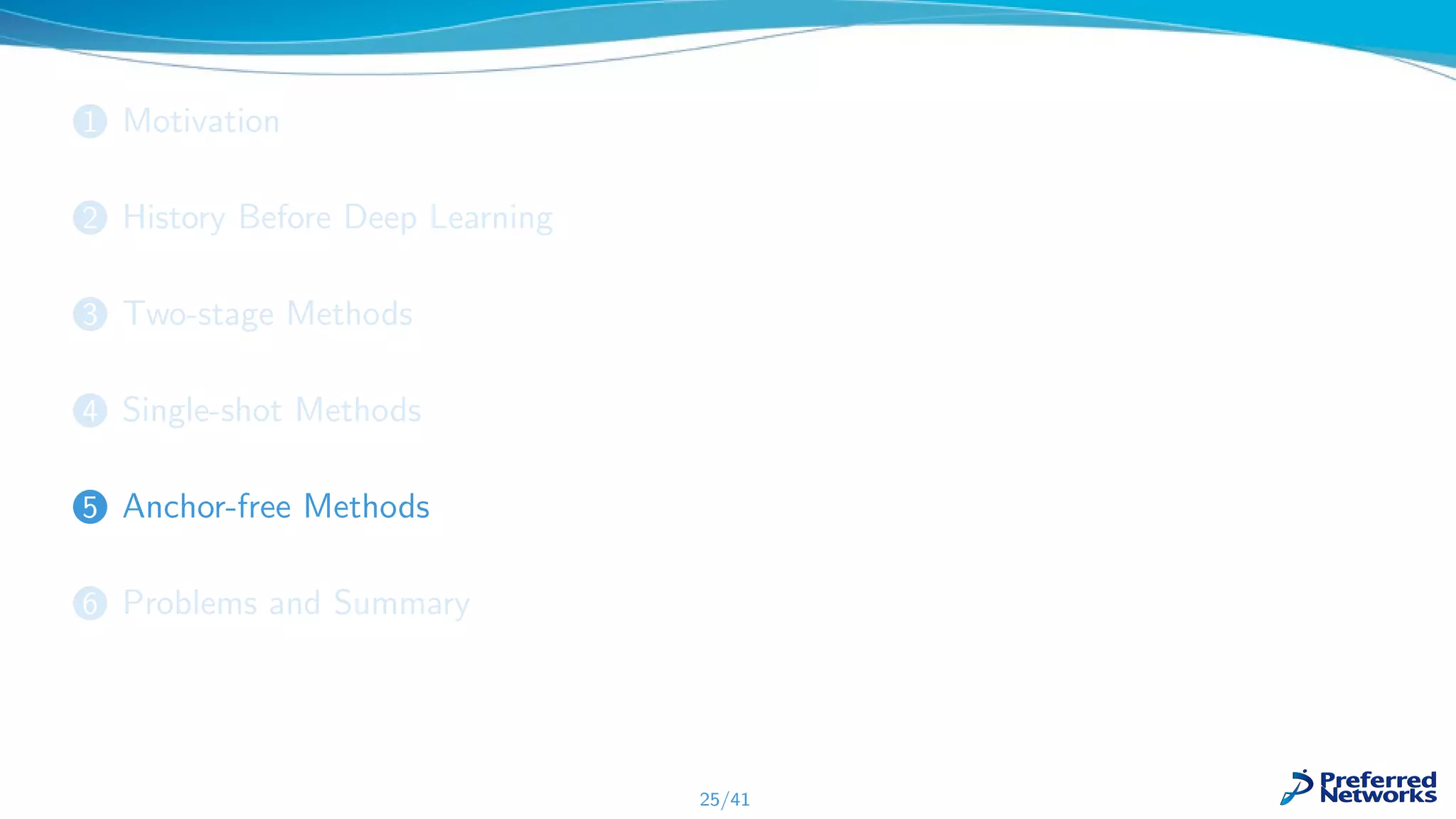
![Anchor-free Methods
• Recently, researchers have tried to remove anchors from object detection methods.
• Why are anchors bad?
• Human-designed prior. (cf. hand-crafted featured vs deep learning on ILSVRC in 2012)
• Anchor-free methods provide more flexibility to leverage large-scale data.
• Why are we able to remove the anchors? Mainly thanks to progress in
• deep keypoint detection research [Newell et al.(2017), Newell and Deng(2017)].
• detection loss formulation, such as focal loss [Lin et al.(2017b)].
• Unlike previous architectures, more similar to semantic segmentation.
• When to use? Instead of single-shot methods for fast and accurate inference.
• If you were thinking of using SSD for your project – think again.
• Caveat: Two-stage methods tend to still be more accurate.
26/41](https://image.slidesharecdn.com/tommi-pfnday4-objctdetection-190926082508/75/A-Brief-History-of-Object-Detection-Tommi-Kerola-30-2048.jpg)
![CornerNet: Detecting Objects as Paired
Keypoints [Law and Deng(2018)]
• First competitive anchor-free method – detect corners of objects.
• Key contributions are corner pooling and improving focal loss for keypoint detection:
27/41
(Fig. from [Law and Deng(2018)])](https://image.slidesharecdn.com/tommi-pfnday4-objctdetection-190926082508/75/A-Brief-History-of-Object-Detection-Tommi-Kerola-31-2048.jpg)
![CenterNet(s): Objects as Points
• Found there are actually two CenterNet papers: posted on arXiv 1 day apart.
• Apr 16: Predict center, regress object size.
• Apr 17: Extend CornerNet to take both corners and centers into account.
28/41
(Figs. from [Zhou et al.(2019b), Duan et al.(2019)])](https://image.slidesharecdn.com/tommi-pfnday4-objctdetection-190926082508/75/A-Brief-History-of-Object-Detection-Tommi-Kerola-32-2048.jpg)
![FCOS: Fully Convolutional One-Stage Object
Detection [Tian et al.(2019)]
• Similar to the Apr 16 CenterNet – predict center, regress object size.
29/41
(Figs. from [Tian et al.(2019)])](https://image.slidesharecdn.com/tommi-pfnday4-objctdetection-190926082508/75/A-Brief-History-of-Object-Detection-Tommi-Kerola-33-2048.jpg)
![Bottom-up Object Detection by Grouping Extreme and Center
Points [Zhou et al.(2019a)]
• Detect not only bboxes, but convex octagons enclosing objects. Same author as Apr
16 CenterNet.
30/41
(Figs. from [Zhou et al.(2019a)])](https://image.slidesharecdn.com/tommi-pfnday4-objctdetection-190926082508/75/A-Brief-History-of-Object-Detection-Tommi-Kerola-34-2048.jpg)
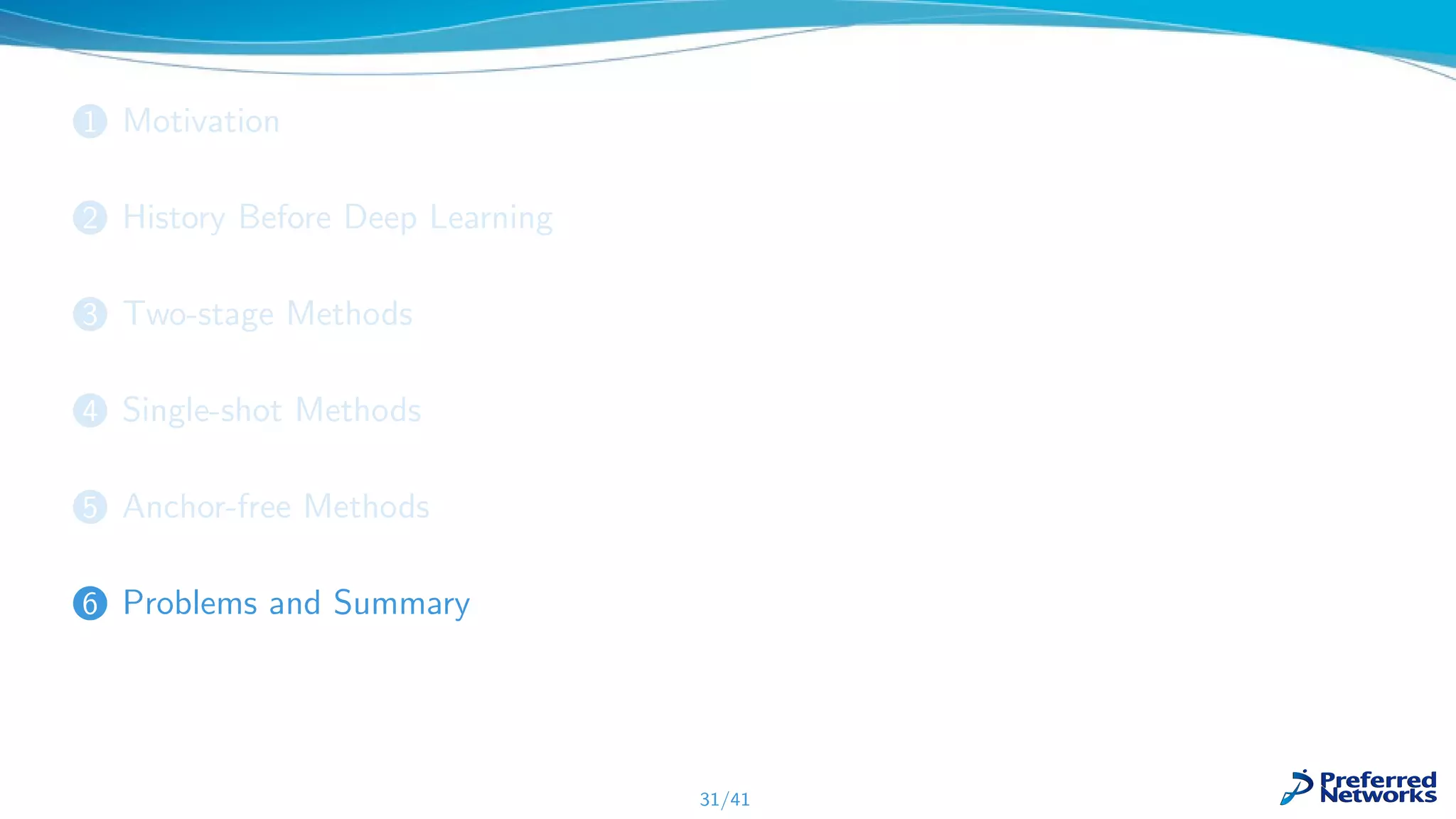
![Problems for Current Object Detection Methods
• Hand-crafted post-processing (NMS) is still required due to correlated detections
• Attempts at “truly” end-to-end object detectors exist, but not
practical [Hu et al.(2018), Hosang et al.(2017)].
• Bounding box representation not optimal – remember the horse?
32/41
(Fig. from telegraph.co.uk)](https://image.slidesharecdn.com/tommi-pfnday4-objctdetection-190926082508/75/A-Brief-History-of-Object-Detection-Tommi-Kerola-36-2048.jpg)
![Problems for Current Object Detection Methods
• Hand-crafted post-processing (NMS) is still required due to correlated detections
• Attempts at “truly” end-to-end object detectors exist, but not
practical [Hu et al.(2018), Hosang et al.(2017)].
• Bounding box representation not optimal – remember the horse?
• You can miss half the horse – and still considered a correct detection!
32/41
(Fig. from telegraph.co.uk)](https://image.slidesharecdn.com/tommi-pfnday4-objctdetection-190926082508/75/A-Brief-History-of-Object-Detection-Tommi-Kerola-37-2048.jpg)
![Problems – and solutions?
• Bounding box representation and hand-crafted NMS not optimal
• New field, panoptic segmentation, tackles this [Kirillov et al.(2019)].
• No need for NMS, as the task requires explaining each pixel, including background
classes.
• Proposes new metric PQ: Panoptic Quality for replacing IoU metric.
33/41
(Fig. from [Kirillov et al.(2019)])](https://image.slidesharecdn.com/tommi-pfnday4-objctdetection-190926082508/75/A-Brief-History-of-Object-Detection-Tommi-Kerola-38-2048.jpg)
